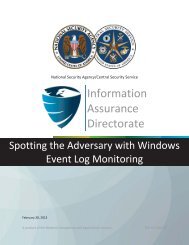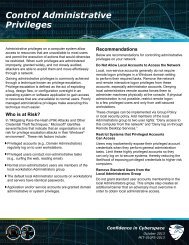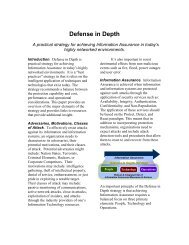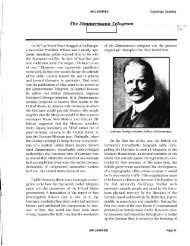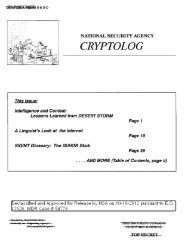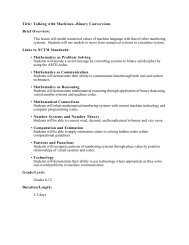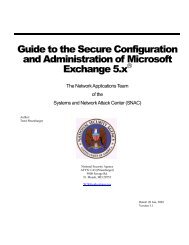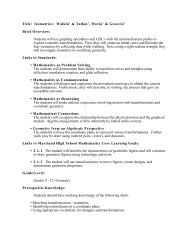Speakers Bureau Speakers Bureau - National Security Agency
Speakers Bureau Speakers Bureau - National Security Agency
Speakers Bureau Speakers Bureau - National Security Agency
Create successful ePaper yourself
Turn your PDF publications into a flip-book with our unique Google optimized e-Paper software.
Pascal’s Triangle<br />
(Appropriate for grades 4-5; minimum time needed is 50 minutes)<br />
Blaise Pascal was a renowned 17th Century French scientist<br />
and mathematician. One of his most important discoveries was a<br />
collection of integers arranged in a triangular fashion which can<br />
easily be computed using only simple addition. Today, we call this<br />
construction Pascal’s Triangle. During the class, the speaker will<br />
guide the students through the generation of Pascal’s Triangle and<br />
then investigate some of the marvelous mathematical properties of<br />
Pascal’s Triangle. Applications covered in class will vary according<br />
to the level and ability of the class and include: elementary<br />
probability, binary arithmetic, sequences and patterns.<br />
Patterns and Number Sequences<br />
(Appropriate for grades 4-5; minimum time needed is 60 minutes)<br />
Students will be introduced to patterns by examining various<br />
arithmetic sequences. The students will determine the “rule” for<br />
generating each sequence. Non-arithmetic sequences will also<br />
be used. Students will then learn about properties of the English<br />
language, such as expected letter frequencies, in order to combine<br />
this knowledge with their pattern-identifying skills to decrypt a<br />
secret message.<br />
Polls, Probability and You<br />
(Appropriate for grades 3-5; minimum time needed is 45 minutes)<br />
This talk introduces students to the concept of probability<br />
through the vehicle of a statistical survey. Appealing to the natural<br />
curiosities of students about themselves, the speaker will conduct<br />
a poll to determine prominent attributes and marked preferences<br />
of the class. Students are then given the opportunity to reveal their<br />
class profile using worksheets to answer pertinent probability<br />
questions. Venn diagrams will be used to assist students in their<br />
assessment of both conditional and unconditional probabilities.<br />
At least two examples of Venn diagrams will be used with two<br />
sets of student characteristics, such as the set of all left-handed<br />
students and the set of all girls in the class. Depending on the level<br />
of the class, a Venn diagram with three sets will be constructed<br />
and analyzed.<br />
8 MEPP – STEM Education Outreach



